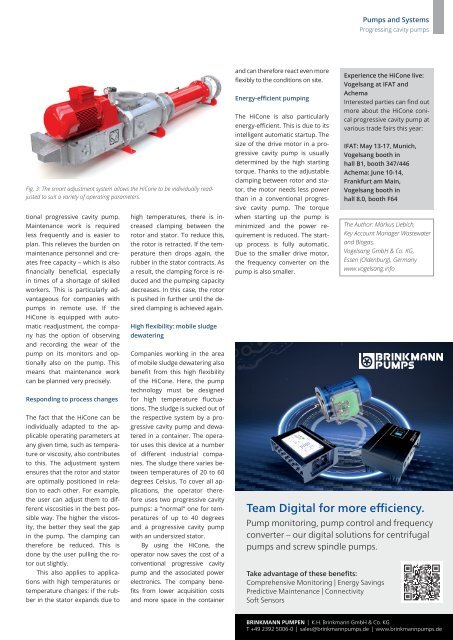PuK - Process Technology & Components 2024
A technical trade magazine with a history of more than 60 years.
A technical trade magazine with a history of more than 60 years.
You also want an ePaper? Increase the reach of your titles
YUMPU automatically turns print PDFs into web optimized ePapers that Google loves.
Pumps and Systems<br />
Progressing cavity pumps<br />
Fig. 3: The smart adjustment system allows the HiCone to be individually readjusted<br />
to suit a variety of operating parameters.<br />
tional progressive cavity pump.<br />
Maintenance work is required<br />
less frequently and is easier to<br />
plan. This relieves the burden on<br />
maintenance personnel and creates<br />
free capacity – which is also<br />
financially beneficial, especially<br />
in times of a shortage of skilled<br />
workers. This is particularly advantageous<br />
for companies with<br />
pumps in remote use. If the<br />
HiCone is equipped with automatic<br />
readjustment, the company<br />
has the option of observing<br />
and recording the wear of the<br />
pump on its monitors and optionally<br />
also on the pump. This<br />
means that maintenance work<br />
can be planned very precisely.<br />
Responding to process changes<br />
The fact that the HiCone can be<br />
individually adapted to the applicable<br />
operating parameters at<br />
any given time, such as temperature<br />
or viscosity, also contributes<br />
to this. The adjustment system<br />
ensures that the rotor and stator<br />
are optimally positioned in relation<br />
to each other. For example,<br />
the user can adjust them to different<br />
viscosities in the best possible<br />
way. The higher the viscosity,<br />
the better they seal the gap<br />
in the pump. The clamping can<br />
therefore be reduced. This is<br />
done by the user pulling the rotor<br />
out slightly.<br />
This also applies to applications<br />
with high temperatures or<br />
temperature changes: if the rubber<br />
in the stator expands due to<br />
high temperatures, there is increased<br />
clamping between the<br />
rotor and stator. To reduce this,<br />
the rotor is retracted. If the temperature<br />
then drops again, the<br />
rubber in the stator contracts. As<br />
a result, the clamping force is reduced<br />
and the pumping capacity<br />
decreases. In this case, the rotor<br />
is pushed in further until the desired<br />
clamping is achieved again.<br />
High flexibility: mobile sludge<br />
dewatering<br />
Companies working in the area<br />
of mobile sludge dewatering also<br />
benefit from this high flexibility<br />
of the HiCone. Here, the pump<br />
technology must be designed<br />
for high temperature fluctuations.<br />
The sludge is sucked out of<br />
the respective system by a progressive<br />
cavity pump and dewatered<br />
in a container. The operator<br />
uses this device at a number<br />
of different industrial companies.<br />
The sludge there varies between<br />
temperatures of 20 to 60<br />
degrees Celsius. To cover all applications,<br />
the operator therefore<br />
uses two progressive cavity<br />
pumps: a “normal” one for temperatures<br />
of up to 40 degrees<br />
and a progressive cavity pump<br />
with an undersized stator.<br />
By using the HiCone, the<br />
operator now saves the cost of a<br />
conventional progressive cavity<br />
pump and the associated power<br />
electronics. The company benefits<br />
from lower acquisition costs<br />
and more space in the container<br />
and can therefore react even more<br />
flexibly to the conditions on site.<br />
Energy-efficient pumping<br />
The HiCone is also particularly<br />
energy-efficient. This is due to its<br />
intelligent automatic startup. The<br />
size of the drive motor in a progressive<br />
cavity pump is usually<br />
determined by the high starting<br />
torque. Thanks to the adjustable<br />
clamping between rotor and stator,<br />
the motor needs less power<br />
than in a conventional progressive<br />
cavity pump. The torque<br />
when starting up the pump is<br />
minimized and the power requirement<br />
is reduced. The startup<br />
process is fully automatic.<br />
Due to the smaller drive motor,<br />
the frequency converter on the<br />
pump is also smaller.<br />
Experience the HiCone live:<br />
Vogelsang at IFAT and<br />
Achema<br />
Interested parties can find out<br />
more about the HiCone conical<br />
progressive cavity pump at<br />
various trade fairs this year:<br />
IFAT: May 13-17, Munich,<br />
Vogelsang booth in<br />
hall B1, booth 347/446<br />
Achema: June 10-14,<br />
Frankfurt am Main,<br />
Vogelsang booth in<br />
hall 8.0, booth F64<br />
The Author: Markus Liebich,<br />
Key Account Manager Wastewater<br />
and Biogas,<br />
Vogelsang GmbH & Co. KG,<br />
Essen (Oldenburg), Germany<br />
www.vogelsang.info<br />
Team Digital for more efficiency.<br />
Pump monitoring, pump control and frequency<br />
converter – our digital solutions for centrifugal<br />
pumps and screw spindle pumps.<br />
Take advantage of these benefits:<br />
Comprehensive Monitoring | Energy Savings<br />
Predictive Maintenance | Connectivity<br />
Soft Sensors<br />
BRINKMANN PUMPEN | K.H. Brinkmann GmbH & Co. KG<br />
T +49 2392 5006-0 | sales@brinkmannpumps.de | www.brinkmannpumps.de

















